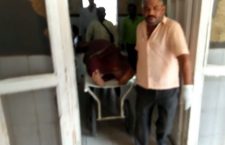A 2016 storm stripped this village in Lalitpur of electricity. They’ve been living in the dark since.
“The pole was damaged in 2016 because of a storm and since then we have had no electricity because nobody has repaired it.” Chandrabahan, a resident of the village of Pachaunda in Mehrauni, Lalitpur, summed up the biggest problem in his village, and one that has now lasted almost three years straight. The village has been in the dark since mid-2016, and it has continued to impact residents’ lives gravely.
“The lack of electricity has been particularly harmful to our crops, because we aren’t able to irrigate our fields in a timely manner,” explained Abhishek, a farmer. And the water problems extend inside their homes too. “People with borewells can’t get drinking water without electricity,” he said, and added the crucial new development that large chunks of Bundelkhand have been facing recently, “as you know, water rarely comes up from mere hand pumps nowadays.”
“This is affecting our future greatly,” said 12th grader Gayatri, when asked about the lack of electricity’s impact on students in the village. “I have my Board exams this year, and I can only prepare for them in the night since I have other work to do in the day.” She elaborated, “But there is no electricity, it’s impossible to study in the night. This will definitely impact my studies and my future.”
“We haven’t been able to use our TVs,” claimed resident Hariram, citing another problem that results in a general drop in awareness, a concern as the elections approaches, “We have no way to watch the news, whether it’s about the campaigning or any new laws.” Mobile phones are the answer of course, but these run into their own problems. “We struggle to find ways to charge them,” said Pachaunda residents.
In 2017, Prime Minister Narendra Modi announced an INR 16,320 crore-electricity-for-all scheme called the PM Sahaj Bijli Har Ghar Yojana or Saubhagya. The aim was to electrify all households, both rural and urban, in the country by December 2018 – a goal claimed to have been met. According to Baldev Prasad, village headman, Saubhagya has nothing to do with Pachaunda, which is a unique case, “Everyone’s homes here are wired and connected to the powerline, so all that was done. But in the storm some damage was done.” But Saubhagya’s mandate is to provide last-mile connectivity to all, even to previously un-electrified households as long as the lack of electricity is not an issue in bill payments. All households in Lalitpur – like the rest of UP – are electrified, as noted on the Saubhagya dashboard, even as specific information about any village, including Pachaunda, is unavailable.
With almost three years of no electricity, Prasad is more than aware of the discontent among the villagers about the situation. “I have made every effort as the pradhan,” he said, “I’ve gone to the department office, I have called the helpline. I’ve made several complaints in the electricity department. I have asked them to repair the problem again and again. I have tried every avenue. They keep telling us they’ll come, but they never do.”
The residents’ themselves have experienced this administrative apathy first-hand. “We’ve asked for this to be fixed repeatedly, we’ve asked the DM and SDM at the chaupal that was put up here when the entire gram panchayat had attended,” said Gayatri firmly, “But there has been no benefit in asking. The first couple of times we complained they told us that the repairs would be done but nothing has happened until now.”
And while at the local Ministry of Power office, the in-charge refused to comment on the matter,
Chandrabhan mentioned another absurd facet of the problem, “Electricity bills still arrive in a timely manner. We are asked to pay money for electricity.”
This Khabar Lahariya article first appeared on Firstpost.

